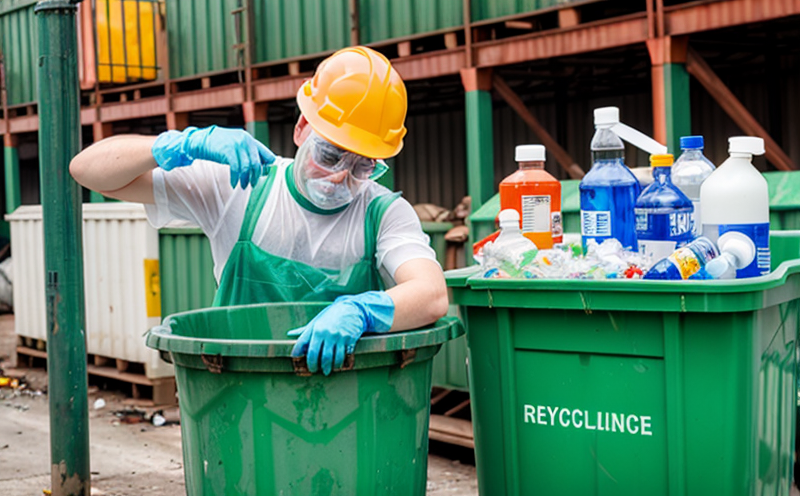ASTM D8086 Organic Compound Testing in Industrial Waste
The ASTM D8086 standard provides a precise method for detecting and identifying organic compounds within industrial waste streams. This service is essential for quality managers, compliance officers, R&D engineers, and procurement teams who need to ensure that their operations comply with environmental regulations while minimizing waste impact.
ASTM D8086 focuses on the quantification of volatile and semivolatile organic compounds (VOCs and SVOCs) in solid industrial wastes. The method involves a multi-step process: sample collection, preparation, extraction, cleanup, identification, and quantification using gas chromatography-mass spectrometry (GC-MS). This approach ensures accurate detection even at low concentrations.
The testing is particularly relevant for industries such as chemical manufacturing, pharmaceuticals, electronics, and petrochemicals. These sectors often generate complex waste streams containing a wide range of organic compounds that can pose environmental risks if not properly managed. By adhering to ASTM D8086, companies ensure they are meeting international standards set by organizations like the Environmental Protection Agency (EPA).
The service includes detailed sample preparation and handling procedures, ensuring accurate results. Specimens undergo rigorous extraction methods using solvent-based systems or solid-phase microextraction techniques followed by cleanup stages to remove interfering substances. This meticulous process guarantees reliable detection of targeted compounds.
| Applied Standards | Description |
|---|---|
| ASTM D8086-21 | This standard specifies the procedure for determining volatile and semivolatile organic compounds in solid waste materials by gas chromatography-mass spectrometry. |
| ISO 15223:2009 | An international standard that provides guidelines on the analysis of organic compounds in water, which can be cross-referenced for similar analytical approaches. |
The identification and quantification steps are critical to ensuring accurate results. Identification is achieved through comparison with reference standards or libraries, while quantification uses peak areas from the chromatogram. This method ensures high specificity and sensitivity, making it suitable for both routine monitoring and compliance assessments.
- Target compounds may include benzene, toluene, ethylbenzene, xylene isomers (BTEX), polycyclic aromatic hydrocarbons (PAHs), and many others depending on the industry type.
The results of ASTM D8086 testing are reported in terms of concentrations by weight or volume. These data help stakeholders make informed decisions regarding waste management, recycling initiatives, and regulatory compliance. For instance, knowing the presence and levels of specific pollutants allows for targeted treatment strategies that can reduce environmental impacts.
Applied Standards
| Standard | Description |
|---|---|
| ASTM D8086-21 | This standard specifies the procedure for determining volatile and semivolatile organic compounds in solid waste materials by gas chromatography-mass spectrometry. |
| ISO 15223:2009 | An international standard that provides guidelines on the analysis of organic compounds in water, which can be cross-referenced for similar analytical approaches. |
The ASTM D8086 method is widely recognized and adopted by regulatory bodies worldwide. It aligns with broader environmental protection goals set forth by organizations like the EPA and EU directives on hazardous waste management. By adhering to this standard, laboratories ensure consistency and comparability of results across different jurisdictions.
Benefits
Compliance with ASTM D8086 offers numerous benefits for industries dealing with industrial waste:
- Regulatory Compliance: Ensures adherence to national and international environmental regulations, reducing the risk of legal penalties.
- Improved Waste Management: Identifies hazardous compounds allowing for more effective disposal or recycling strategies.
- Risk Reduction: Early detection of potential pollutants minimizes exposure risks during waste handling operations.
- Data-Driven Decisions: Provides robust data to support strategic planning around waste reduction and resource recovery initiatives.
Beyond regulatory compliance, ASTM D8086 testing supports sustainable practices by enabling informed decision-making regarding waste treatment options. This can lead to significant cost savings through optimized recycling processes or the development of new eco-friendly products from recovered materials.
Use Cases and Application Examples
The application of ASTM D8086 extends beyond mere compliance; it plays a crucial role in various industrial settings:
| Industry Sector | Purpose |
|---|---|
| Chemical Manufacturing | Detects process by-products that could contaminate waste streams. |
| Pharmaceutical Production | Identifies solvents used in drug synthesis that might otherwise go unreported. |
| Petrochemical Processing | Monitors emissions from distillation processes to prevent air pollution. |
In each case, ASTM D8086 helps pinpoint specific organic compounds responsible for environmental concerns. For example, in petrochemical processing, the presence of benzene and other aromatic hydrocarbons must be controlled to meet emission limits set by regulatory bodies.
- Case Study: A large chemical manufacturer used ASTM D8086 testing to identify BTEX compounds in its waste stream. The findings led to the implementation of a new solvent recovery system, reducing overall disposal costs and environmental impact significantly.
The method's versatility allows it to be adapted to various scenarios where accurate organic compound analysis is required. Whether for routine monitoring or specific compliance audits, ASTM D8086 remains a valuable tool in modern waste management practices.





